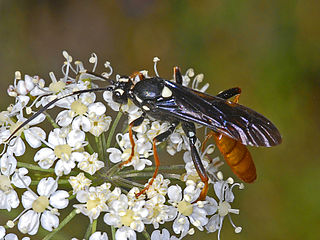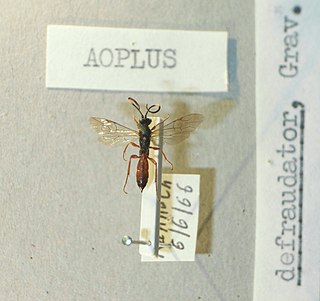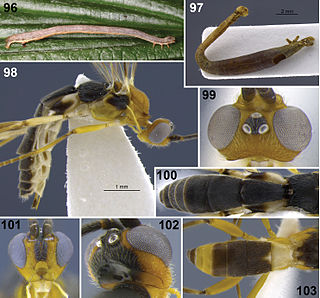
Metrioptera is a genus of insects in the tribe Platycleidini and subfamily Tettigoniinae, include the bog and meadow bush crickets. They are found in Eurasia.

Evagetes is a genus of spider wasps from the family Pompilidae. There are 72 described species, of which 58 are found in the Palaearctic region, 11 in the Nearctic region, with a few penetrating to the Afrotropical, Oriental and Neotropic regions. Evagetes wasps are kleptoparasitic on other pompilid wasps, especially the genera Arachnospila, Anoplius, Episyron and Pompilus, digging into their sealed burrows, eating the host egg and replacing it with an egg of its own. Evagetes wasps are characterised by their very short antennae. Most are species are black with the base of the antennae rufous, several Evagetes species are very metallic bluish insects.

Amblyjoppa fuscipennis is a species of the parasitic wasp in the family Ichneumonidae. It was first described by Constantin Wesmael in 1844.

Aoplus defraudator is a species of wasp in the genus Aoplus. It was first identified by Constantin Wesmael, in 1845.

Oxybelus is a genus of wasps in the family Crabronidae. The species are found worldwide except in the Australasian realm. They are especially represented in the Palearctic. Oxybelus is the largest genus in Crabronidae, with 264 species known. Oxybelus wasps sometimes gravitate towards people, flying around travellers and landing on them, even when they are shooed away. It is not known why they do it, however it might possibly be them trying to drink sweat for its minerals.

Aleiodes is a genus of the family Braconidae of parasitoid wasps described by Constantin Wesmael in 1838. They are also known as mummy-wasps.

Aoplus is a genus of insects belonging to the family Ichneumonidae.
Phaeogenes is a genus of parasitoid wasps belonging to the family Ichneumonidae.

Diadromus is a genus of parasitoid wasps belonging to the family Ichneumonidae.
Tycherus is a genus of parasitoid wasps belonging to the family Ichneumonidae.

Oronotus is a genus of parasitoid wasps belonging to the family Ichneumonidae.
Hypomecus is a genus of parasitoid wasps belonging to the family Ichneumonidae.
Herpestomus is a genus of parasitoid wasps belonging to the family Ichneumonidae.
Exephanes is a genus of parasitoid wasps belonging to the family Ichneumonidae.

Centeterus is a genus of parasitoid wasps belonging to the family Ichneumonidae.
Colpognathus is a genus of parasitoid wasps belonging to the family Ichneumonidae.
Dicaelotus is a genus of parasitoid wasps belonging to the family Ichneumonidae.
Eurylabus is a genus of ichneumon wasps in the family Ichneumonidae. There are about 11 described species in Eurylabus.

Listrodromus nycthemerus, the holly blue Darwin wasp, is a species of ichneumon wasp belonging to the family Ichneumonidae. This species is a parasitoid, its sole host species being the holly blue butterfly.

Listrodromus is a genus of ichneumon wasps belonging to the family Ichneumonidae. These wasps are parasitoids of butterflies of the family Lycaenidae, laying eggs in the caterpillars.









